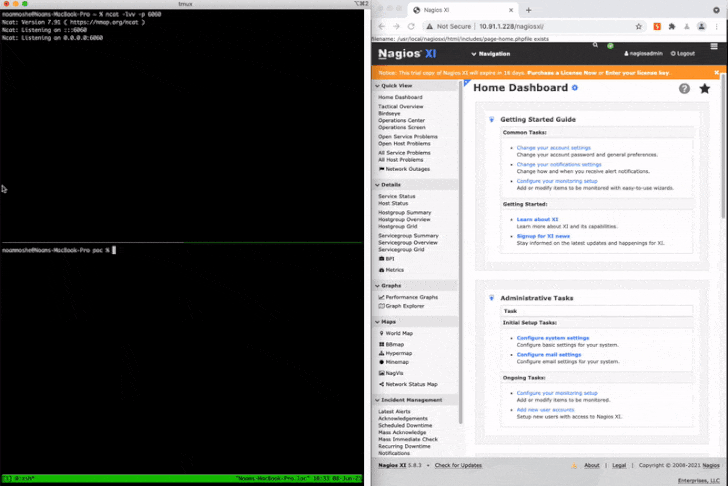As many as 11 security vulnerabilities have been disclosed in Nagios network management systems, some of which could be chained to achieve pre-authenticated remote code execution with the highest privileges, as well as lead to credential theft and phishing attacks.
Industrial cybersecurity firm Claroty, which discovered the flaws, said flaws in tools such as Nagios make them an attractive target owing to their "oversight of core servers, devices, and other critical components in the enterprise network." The issues have since been fixed in updates released in August with Nagios XI 5.8.5 or above, Nagios XI Switch Wizard 2.5.7 or above, Nagios XI Docker Wizard 1.13 or above, and Nagios XI WatchGuard 1.4.8 or above.
"SolarWinds and Kaseya were likely targeted not only because of their large and influential customer bases, but also because of their respective technologies' access to enterprise networks, whether it was managing IT, operational technology (OT), or internet of things (IoT) devices," Claroty's Noam Moshe said in a write-up published Tuesday, noting how the intrusions targeting the IT and network management supply chains emerged as a conduit to compromise thousands of downstream victims.
Nagios Core is a popular open-source network health tool analogous to SolarWinds Network Performance Monitor (NPM) that's used for keeping tabs on IT infrastructure for performance issues and sending alerts following the failure of mission-critical components. Nagios XI, a proprietary web-based platform built atop Nagios Core, provides organizations with extended insight into their IT operations with scalable monitoring and a customizable high-level overview of hosts, services, and network devices.
Chief among the issues are two remote code execution flaws (CVE-2021-37344, CVE-2021-37346) in Nagios XI Switch Wizard and Nagios XI WatchGuard Wizard, an SQL injection vulnerability (CVE-2021-37350) in Nagios XI, and a server-side request forgery (SSRF) affecting Nagios XI Docker Wizard, as well as a post-authenticated RCE in Nagios XI's Auto-Discovery tool. The complete list of 11 flaws is as follows -
CVE-2021-37343 (CVSS score: 8.8) - A path traversal vulnerability exists in Nagios XI below version 5.8.5 AutoDiscovery component and could lead to post-authenticated RCE under the security context of the user running Nagios. CVE-2021-37344 (CVSS score: 9.8) - Nagios XI Switch Wizard before version 2.5.7 is vulnerable to remote code execution through improper neutralization of special elements used in an OS Command (OS Command injection). CVE-2021-37345 (CVSS score: 7.8) - Nagios XI before version 5.8.5 is vulnerable to local privilege escalation because xi-sys.cfg is being imported from the var directory for some scripts with elevated permissions. CVE-2021-37346 (CVSS score: 9.8) - Nagios XI WatchGuard Wizard before version 1.4.8 is vulnerable to remote code execution through Improper neutralization of special elements used in an OS Command (OS Command injection). CVE-2021-37347 (CVSS score: 7.8) - Nagios XI before version 5.8.5 is vulnerable to local privilege escalation because getprofile.sh does not validate the directory name it receives as an argument. CVE-2021-37348 (CVSS score: 7.5) - Nagios XI before version 5.8.5 is vulnerable to local file inclusion through an improper limitation of a pathname in index.php. CVE-2021-37349 (CVSS score: 7.8) - Nagios XI before version 5.8.5 is vulnerable to local privilege escalation because cleaner.php does not sanitize input read from the database. CVE-2021-37350 (CVSS score: 9.8) - Nagios XI before version 5.8.5 is vulnerable to SQL injection vulnerability in Bulk Modifications Tool due to improper input sanitization. CVE-2021-37351 (CVSS score: 5.3) - Nagios XI before version 5.8.5 is vulnerable to insecure permissions and allows unauthenticated users to access guarded pages through a crafted HTTP request to the server. CVE-2021-37352 (CVSS score: 6.1) - An open redirect vulnerability exists in Nagios XI before version 5.8.5 that could lead to spoofing. To exploit the vulnerability, an attacker could send a link that has a specially-crafted URL and convince the user to click the link. CVE-2021-37353 (CVSS score: 9.8) - Nagios XI Docker Wizard before version 1.1.3 is vulnerable to SSRF due to improper sanitization in table_population.phpIn a nutshell, the flaws could be combined by attackers to drop a web shell or execute PHP scripts and elevate their privileges to root, thus achieving arbitrary command execution in the context of the root user. As a proof-of-concept, Claroty chained CVE-2021-37343 and CVE-2021-37347 to gain a write-what-where primitive, allowing an attacker to write content to any file in the system.
"[Network management systems] require extensive trust and access to network components in order to properly monitor network behaviors and performance for failures and poor efficiency," Moshe said.
"They may also extend outside your network through the firewall to attend to remote servers and connections. Therefore, these centralized systems can be a tasty target for attackers who can leverage this type of network hub, and attempt to compromise it in order to access, manipulate, and disrupt other systems."
The disclosure is the second time nearly dozen vulnerabilities have been disclosed in Nagios. Earlier this May, Skylight Cyber revealed 13 security weaknesses in the network monitoring application that could be abused by an adversary to hijack the infrastructure without any operator intervention.
Found this article interesting? Follow THN on Facebook, Twitter and LinkedIn to read more exclusive content we post.
.png)
 3 years ago
296
3 years ago
296 


















 Bengali (Bangladesh) ·
Bengali (Bangladesh) ·  English (United States) ·
English (United States) ·